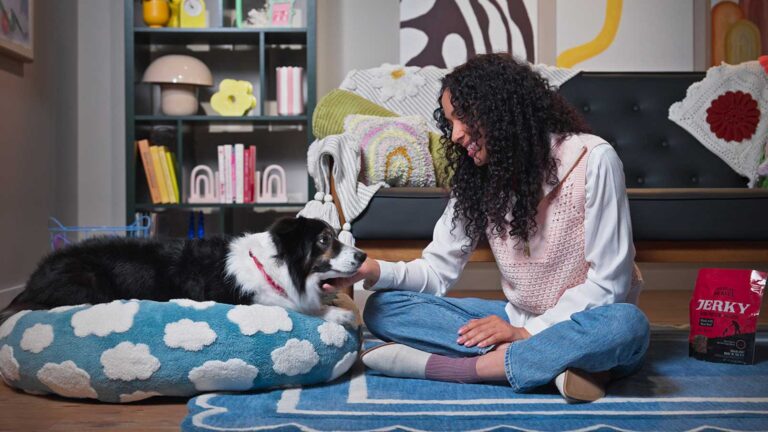How to Teach a Dog to Come When Called in Just 5 Steps
Nothing is more terrifying than when your pup runs off and you can’t get them to come back. Cue the dog “come” command. Teaching your dog to come when called helps keep them out of dangerous situations, like if a wild animal gets into the yard, or if you’re walking them off leash and they run too far ahead.
Learning how to teach a dog to come also opens up more possibilities for off-leash time for your dog since you know they’ll reliably come back, and that means they get greater freedom to explore their world. You get peace of mind, and they get more time to sniff all the things. Now that’s what we call a win-win!
How to Teach a Dog to Come When Called
Whether you want to know how to teach a puppy to come or you’ve got an older pup who’s ready to learn a new trick, follow these steps.
Supplies You'll Need
✓A quiet space
✓A long leash (10+ feet)
✓ Training treats for dogs, like Zuke’s Mini Naturals Chicken treats
✓15 to 20 minutes per day
✓Patience
✓Enthusiasm
What Is Recall?
In dog training, the term recall refers to the ability to come when called. “Reliable recall” means you can expect your dog to come to you whenever you call them.
Recommended Products

1. Start in a safe, quiet spot.
Find an area with minimal distractions to begin training. This could be your backyard or somewhere in your home. Allow your dog to wander and explore.

2. Say your dog's name, then tell them to come to you.
After about five minutes, say your dog’s name and then give your dog the “come” command (literally say the word “come”). As they start moving toward you, encourage your dog by cheering them on. You can even praise your dog for looking in your direction after saying “come” in these early stages of training. (FYI, in the dog training world, command and cue are interchangeable words.)
Pro Tip: Our body language and tone are important. We want to be loose and fun and use a sing-song, happy voice when calling them. If we sound stern or look scary, your dog will likely try to avoid you. Also, be consistent with the word you use. For example, always say “come” instead of switching back and forth to “here” or another word.

3. Give your dog a treat.
Reward your dog with tasty training treats once they approach you and make sure to give them some happy scratches, pats and rubs. This helps them know they did a good job. You could also surprise them with their favorite toy!

4. Repeat several more times.
Let your puppy go back to exploring some more, and then repeat Steps 1-3. Aim for 15- to 20-minute training sessions and repeat every day or two so that it becomes better ingrained in their head. With consistent training sessions, you can expect your dog to reliably come when called within one to two months. Some dogs might take longer or shorter to achieve a reliable recall.
Pro Tip: Once your dog can consistently recall the command “come,” gradually increase the distance between you. You can also go somewhere with some more distractions, such as the dog park. This helps them truly master the skill!

5. Practice whenever you can.
Once your dog has a firm recall cue, you can start to use it in everyday scenarios, such as on a walk or when hanging out at home. You can even have dog park training sessions. Wherever you are, randomly ask your dog to come, and if they do, then give them a “jackpot reward.” This is when you give them three to five bits of tasty treats, one at a time, while praising them with each reward. This will make your puppy feel like they just won the lottery, and they will associate the come command with affection and treats.
Things to Avoid
Knowing how to teach a dog to come requires a lot of patience and a good attitude. It’s very important to only engage in a training session when you’re feeling relaxed, happy, and can dedicate a block of time to your dog.
Also, as you are teaching the dog the come command, it’s important to align it with only positive reinforcement, which means reinforcing positive behaviors versus punishing bad behaviors. Do not call your dog when you’re upset or to punish them. Even calling a dog inside to be crated, leaving a doggy play sesh, or getting an unwanted bath can be detrimental to their ability to recall the command later.
To recap, don’t do the following:
- Don’t rush it.
- Don’t start a training session if you are already stressed or in a bad mood.
- Don’t call your dog to punish them.
- Don’t call your dog in upsetting situations.
Off-leash Dog Safety
Reliable recall is the foundation of a safe off-leash adventure for your pup—but there’s more to consider, too. Follow these tips:
- Practice the “come” command in a fenced backyard or park before allowing your dog to roam freely in open spaces.
- Carry a leash with you, even if you expect your dog to remain off-leash, so you can leash them in the event that their training slips.
- Ensure your dog is microchipped and that their ID tag has your most recent contact information on it, just in case they do get lost.
How to Teach a Dog To Come When Called FAQs
Can I teach my dog to come without treats?
Using treats at the beginning stages helps you lay the foundation for a relationship in which your dog is more eager to spend time with you and comes to you because they know good things happen whenever you call. In other words, getting a fast, energetic response to your “come” cue starts with being generous with treats.
If you’re concerned about giving your pup extra calories, break the treats into smaller pieces and stick to low-fat, low-sugar and low-calorie treats. You can also supplement with their favorite toy and, of course, plenty of happy belly rubs and encouragement.
How can I teach my dog to come when I whistle?
Teaching a dog to come when you blow a whistle is a great idea! The whistle can act as an “emergency” fallback signal if your dog can’t hear you calling in a noisy environment, for instance, or when the dog is very far away.
To teach a dog to come to a whistle, start by standing in front of your dog inside your home. Blow the whistle, then feed them five to 10 tiny treats in a row, right in their mouth. Wait 30 seconds, then repeat. Do this twice a day for a week.
After a week has passed, repeat this process but stand further away from your dog (about three feet). Most dogs will step toward you. Once they begin moving your way, start to hand feed your dog their treats. (If they do not come to you, then go back to standing in front of them.) Continue this process, gradually increasing the distance between you.
How can I teach my dog to not come?
Teaching your dog how to “not come” is going to be tricky since it uses the same word that tells them to move toward you. Instead, teach them the “sit” or “stay” cue. We have created helpful guides that walk you through the sit command and stay command.
Can I teach a senior dog to come when called?
Yes, you can teach a senior dog to come when called. Teaching a puppy to come may be a little easier, on average, than teaching a senior dog since older pups tend to be more set in their ways. In some cases, though, training a senior dog might be easier since younger dogs are notoriously distracted by what’s happening around them.
You can teach your senior dog to come when called by following the steps above (either using the verbal cue “come” or a whistle). If they’re hard of hearing, use a hand signal instead. Be considerate of your senior dog’s limits, and make sure to reward them handsomely.
The Bottom Line
Training a dog to come requires you to build a positive relationship with your new puppy and to establish a strong foundation of trust and respect. If you continually use negative corrections (such as scolding) with your dog, they will not be as inclined to come to you when called. That is why positive reinforcement training is so useful when starting your pup down their obedience training path.














